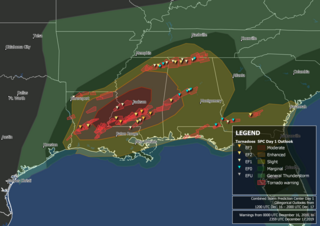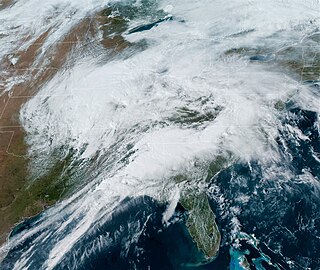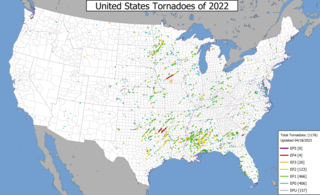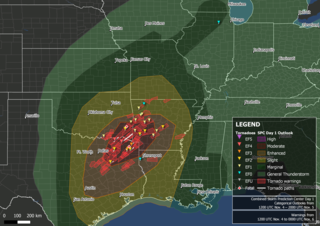
This page documents notable tornadoes and tornado outbreaks worldwide in 2016. Strong and destructive tornadoes form most frequently in the United States,Bangladesh,Brazil and Eastern India,but they can occur almost anywhere under the right conditions. Tornadoes also develop occasionally in southern Canada during the Northern Hemisphere's summer and somewhat regularly at other times of the year across Europe,Asia,and Australia. Tornadic events are often accompanied with other forms of severe weather,including strong thunderstorms,strong winds,and hail. There were 1,059 tornadoes reported in the United States in 2016,of which 974 were confirmed. Worldwide,133 fatalities were reported:100 in China,18 in the United States,five in Uruguay,four in Brazil and two in Italy,Russia and Indonesia each.

A significant four-day outbreak of tornadoes impacted areas across the High Plains,central Midwest,and parts of the Ohio Valley in early May. The outbreak also produced the first EF4 tornado of the year in Katie,Oklahoma on May 9,where one death occurred. An EF3 tornado near Connerville,Oklahoma also killed a person that day. Other notable tornadoes included two large EF2 tornadoes in Colorado on May 7,a large EF2 tornado near Catherine,Kansas on May 8,and a destructive EF3 tornado that struck Mayfield,Kentucky on May 10. Overall,57 tornadoes were confirmed.

The tornado outbreak of February 28 –March 1,2017 was a widespread and significant outbreak of tornadoes and severe weather that affected the Midwestern United States at the end of February 2017 and beginning of March. Fueled by the combination of ample instability,strong wind shear,and rich low-level moisture,the event led to 71 confirmed tornadoes and thousands of other non-tornadic severe weather reports. The most notable aspect of the outbreak was a long-tracked EF4 tornado—the first violent tornado of 2017 and the first violent tornado during the month of February since the 2013 Hattiesburg tornado—that tracked from Perryville,Missouri to near Christopher,Illinois,killing one person. Three EF3 tornadoes were recorded during the event,including one that caused two fatalities in Ottawa,Illinois,one that caused a fatality near Crossville,and one that heavily damaged or destroyed homes in and around Washburn. In addition to the deaths,38 people were injured by tornadoes and an additional 30 were injured by non-tornadic impacts,mainly by fallen trees.

This page documents notable tornadoes and tornado outbreaks worldwide in 2019. Strong and destructive tornadoes form most frequently in the United States,Argentina,Brazil,Bangladesh,and Eastern India,but can occur almost anywhere under the right conditions. Tornadoes also develop occasionally in southern Canada during the Northern Hemisphere's summer and somewhat regularly at other times of the year across Europe,Asia,Argentina,and Australia. Tornadic events are often accompanied by other forms of severe weather,including strong thunderstorms,strong winds,and hail.

The tornado outbreak sequence of May 2019 was a prolonged series of destructive tornadoes and tornado outbreaks affecting the United States over the course of nearly two weeks,producing a total of 400 tornadoes,including 53 significant events (EF2+). Eighteen of these were EF3 tornadoes,spanning over multiple states,including Nebraska,Kansas,Texas,Missouri,Oklahoma,Indiana,Iowa,and Ohio,with additional tornadoes confirmed across a region extending from California to New Jersey. Two EF4 tornadoes occurred,one in Dayton,Ohio,and the other in Linwood,Kansas. Four tornadoes during this outbreak were fatal,causing a total of eight fatalities. The deadliest of these occurred on May 22 near Golden City,Missouri,where an EF3 tornado took three lives,including an elderly couple in their eighties. The damaging series of tornadoes that occurred in Indiana and Ohio on the evening of May 27 during this event is sometimes locally referred to as the Memorial Day tornado outbreak of 2019,which became the fourth costliest weather event in Ohio history. The near continuous stream of systems also produced to widespread flash and river flooding,along with damaging winds and large hail.

A significant severe weather and tornado outbreak affected the Southern United States between December 16–17,2019. Discrete supercells developed in the early morning on December 16 and moved northeast,spawning multiple strong,long-tracked tornadoes in cities such as Alexandria and in Laurel before congealing into an eastward-moving squall line. During the outbreak,the National Weather Service issued several PDS tornado warnings as well as a rare tornado emergency for Alexandria. In addition to this,the Storm Prediction Center issued six tornado watches for the outbreak. The event happened to take place on the same date of another outbreak in a similar area 19 years earlier.

A small but deadly tornado outbreak affected West and Middle Tennessee on the night of March 2 and into the morning of March 3,2020,including a high-end EF3 tornado that hit Nashville and Mount Juliet,becoming the 6th costliest tornado in United States history,and a violent EF4 tornado that impacted areas in and just west of Cookeville. A total of 25 people were killed by the tornadoes,with an additional 309 being injured,and more than 70,000 lost electricity. The path of the Nashville tornado was very similar to the one that hit East Nashville in 1998. A few additional tornadoes were also confirmed in Alabama,southeastern Missouri,and western Kentucky. Total damage from the event reached $1.607 billion according to the National Centers for Environmental Information.

A widespread and deadly tornado outbreak affected the Southeastern United States on Easter Sunday and Monday,April 12–13,2020. Several tornadoes were responsible for prompting tornado emergencies,including the first one to be issued by the National Weather Service in Charleston,South Carolina. A large squall line formed and tracked through the mid-Atlantic on April 13,prompting more tornado warnings and watches. A total of 15 watches were produced during the course of the event,two of which were designated Particularly Dangerous Situations.

A significant tornado outbreak sequence took place from March 24–28,2021 in the Southern United States,just one week after another outbreak affected similar regions. There were 43 tornadoes confirmed across 11 states,with the bulk of activity primarily on March 25,which resulted in the Storm Prediction Center (SPC) issuing its second high-risk outlook for the month of March,as well as the second high-risk outlook for 2021. Several intense tornadoes touched down on that day,including ones that prompted the issuance of rare tornado emergencies near Hoover,Alabama,Brent and Centreville,Alabama,and in the Newnan,Georgia area. March 27 also saw widespread tornado activity mainly across East Texas,Southern Arkansas,Louisiana,and Western Tennessee with several strong tornadoes touching down. Scattered to widespread wind and hail damage occurred throughout the outbreak sequence,and repeated rounds of heavy rain caused widespread severe flash and river flooding across much of Tennessee.

This page documents notable tornadoes and tornado outbreaks worldwide in 2022. Strong and destructive tornadoes form most frequently in the United States,Argentina,Brazil,Bangladesh,and Eastern India,but can occur almost anywhere under the right conditions. Tornadoes also develop occasionally in southern Canada during the Northern Hemisphere's summer and somewhat regularly at other times of the year across Europe,Asia,Argentina,Australia and New Zealand. Tornadic events are often accompanied by other forms of severe weather,including strong thunderstorms,strong winds,and hail. Worldwide,32 tornado-related deaths were confirmed:23 in the United States,three in China,two each in Poland and Russia,and one each in the Netherlands and Ukraine.

From April 4–5,2022,a mesoscale convective system and numerous discrete supercells produced a swath of severe weather and several tornadoes in the Southeastern United States,including several strong,long tracked tornadoes. An EF3 tornado damaged or destroyed several homes in Bonaire,Georgia while a large EF3 tornado prompted a tornado emergency for Allendale and Sycamore,South Carolina. A violent EF4 tornado in Black Creek,Georgia resulted in one fatality as it destroyed several neighborhoods,and another large EF3 tornado caused widespread heavy tree damage northeast of Ulmer,South Carolina. More severe storms occurred across a large portion of the Southeast ahead of a cold front on April 6–7,with more tornadoes reported in South and Central Georgia and further south into Florida,all of which were weak. Along with the one tornadic death,trees felled by straight-line winds killed one person each in Louisiana and Texas.

A significant late-season tornado outbreak took place on November 4,2022,across Northeast Texas,southwestern Arkansas,southeastern Oklahoma,and northwestern Louisiana with multiple large,destructive tornadoes occurring over a span of several hours. Major damage was reported in Sulphur Springs,Powderly,Caviness,Paris,Cason,Daingerfield,Athens,New Boston,Texas,and Idabel,Oklahoma,with the latter two communities being placed under tornado emergencies. Two fatalities occurred in Cason,Texas,and Pickens,Oklahoma respectively. Numerous PDS tornado warnings were issued as well. An additional tornado embedded within a narrow,but intense line of showers with damaging winds was also confirmed in Illinois the following morning as the system progressed eastward. Strong winds affected most of the western Great Lakes throughout the day before moving into Canada that evening. Two fatalities and at least 34 injuries were confirmed from tornadoes,and an additional fatality occurred near Stilwell,Oklahoma from drowning.

An early-season tornado outbreak impacted the Southeastern United States on January 12,2023. The result of a mid-level trough moving through,moisture and the presence of a strong low-level jet aided in the development of numerous severe and tornadic thunderstorms. Early in the outbreak,a strong EF2 tornado caused considerable damage in Winston County,Alabama,while another EF2 tornado struck just south of Greensboro. A destructive high-end EF2 tornado struck Selma,causing widespread damage and two injuries. The same storm produced a long-lived EF3 tornado that moved through or near Old Kingston,Titus,Equality,and Lake Martin,resulting in seven fatalities and several injuries in Autauga County alone. Another EF2 tornado from the storm struck areas in or around Five Points and Standing Rock before crossing into Georgia. After the dissipation of that tornado,nine more tornadoes,five of which were strong,caused heavy damage across west-central Georgia,especially in LaGrange,Griffin,and Experiment,the second one of which was impacted by four tornadoes in the span of 10 minutes,including two that were rated EF2 and EF3 respectively. Another EF2 tornado from the storm caused major damage and another fatality in the Jackson Lake area as well;an indirect death from the tornado also occurred the following day. Elsewhere,other tornadoes caused damage in Sumter and Mobile counties in Alabama,as well as parts of Mississippi,Tennessee,Kentucky,Illinois,and the Carolinas. In all,43 tornadoes were confirmed.

On March 24,2023,a severe weather and tornado outbreak began across portions of the lower Mississippi River Valley in the United States. A slow-moving trough moved eastward across the United States and interacted with a moist and unstable airmass originating from the Gulf of Mexico,resulting in widespread heavy rainfall,severe thunderstorms,and significant tornadoes over a four-day period. A violent high-end EF4 tornado moved through the towns of Rolling Fork,Midnight,and Silver City in western Mississippi,causing catastrophic damage and many fatalities. Multiple tornado emergencies were issued for that tornado and two subsequent EF3 tornadoes from the same supercell that struck Winona and Amory.

Throughout the afternoon hours of April 26,2024,a large,violent,and destructive tornado impacted parts of the communities of Waterloo,Elkhorn,Bennington,and Blair,Nebraska,injuring four people. The tornado was the first of two EF4 tornadoes during the tornado outbreak of April 25–28,2024. The tornado reached peak intensity in the neighborhood of Elkhorn and south of the city of Blair,leading the National Weather Service in Omaha,Nebraska to assign a rating of low-end EF4 on the Enhanced Fujita scale,with maximum wind speeds estimated at 170 mph (270 km/h).

From April 25 to 28,2024,a very large,deadly and destructive tornado outbreak occurred across the Midwestern,Southern,and High Plains regions of the United States,primarily on April 26 and 27. On April 26,the Storm Prediction Center (SPC) first issued an enhanced risk for the Plains,as a broad upper-trough moved eastwards,with strong tornadic activity erupting in the states of Nebraska,Iowa,and Kansas later that day. A high-end EF3 tornado struck the northeastern outskirts of Lincoln,Nebraska in Lancaster County,injuring three people. A long-tracked low-end EF4 tornado caused widespread severe damage in Elkhorn and near Bennington and Blair,and prompted the issuance of two tornado emergencies. Another EF3 tornado moved through parts of both Omaha and Council Bluffs,Iowa as well as points northeast,injuring four more people. Another long-tracked EF3 tornado moved directly through Minden,Iowa,killing one person and injuring three others,prompting the issuance of two more tornado emergencies. An EF2 tornado also moved through Pleasant Hill just southeast of Des Moines,injuring one person.

A multi-day period of significant tornado activity along with significant derechos occurred across the Midwestern United States and the Mississippi Valley as well as an additional tornado in the Canadian province of Quebec. From May 19–27,2024,two derechos occurred and tornadoes were reported across large portions of the Central United States,with multiple Particularly Dangerous Situation (PDS) watches issued across the sequence. On May 19,strong tornadoes occurred with isolated supercells in Colorado and Oklahoma while a derecho produced widespread wind damage and weak tornadoes across Kansas into the early morning hours of May 20. Limited tornadic activity took place on May 20,but another outbreak along with widespread damage struck mainly Iowa and Wisconsin on May 21. Five fatalities were confirmed with a large,violent,long-tracked EF4 tornado that went through Greenfield,Iowa. Scattered to widespread severe weather and tornadoes occurred over the next two days,including an EF2 tornado that injured 30 people on the west side of Temple,Texas. Another derecho formed in southwestern Nebraska late on May 23 and moved eastward,producing widespread wind damage and weak tornadoes through Nebraska and Iowa and northwestern Illinois before withering away in the northern part of the state during the morning hours of May 24.

The 2013 Granbury tornado was a violent and destructive EF4 tornado that struck Granbury,Texas in the evening hours of May 15,2013. It killed 6 people,making it the deadliest tornado of the Tornado outbreak of May 15–17,2013,and was one of the worst tornadoes to ever hit the region.

On April 27,2011,a large,long-tracked and violent tornado that struck the multiple towns and areas of Lake Martin in eastern Alabama,killing seven people and injuring 30 others. The tornado caused $167 million in damages and was part of the 2011 Super Outbreak.

On May 9,2016,a violent multi-vortex EF4 tornado struck southern Katie,Oklahoma. The tornado was extremely erratic and killed one person while causing $1,000,000 in damages. The tornado was extremely photogenic,and was heavily documented by storm chasers and civilians.





















